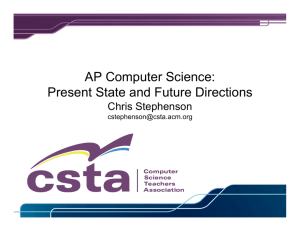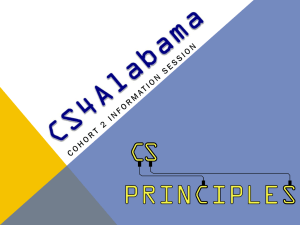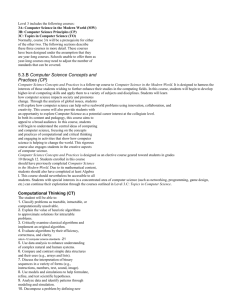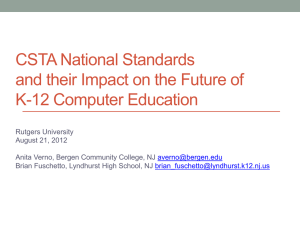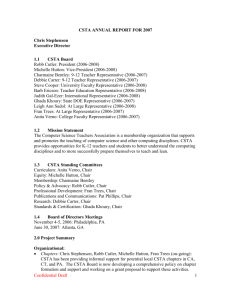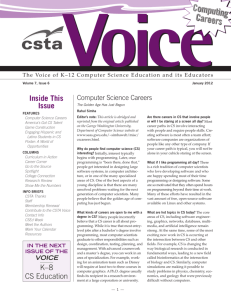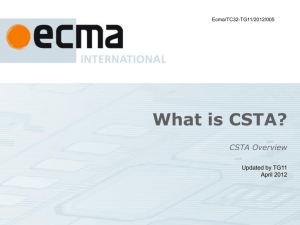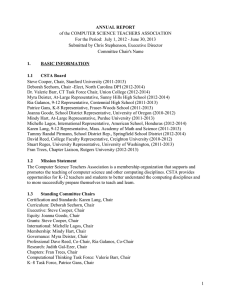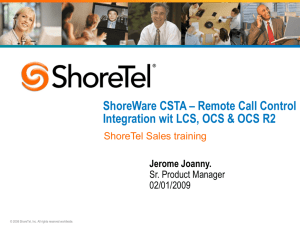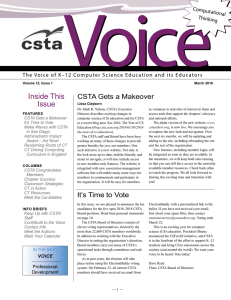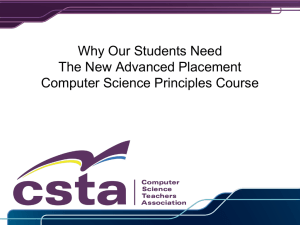Slides
advertisement
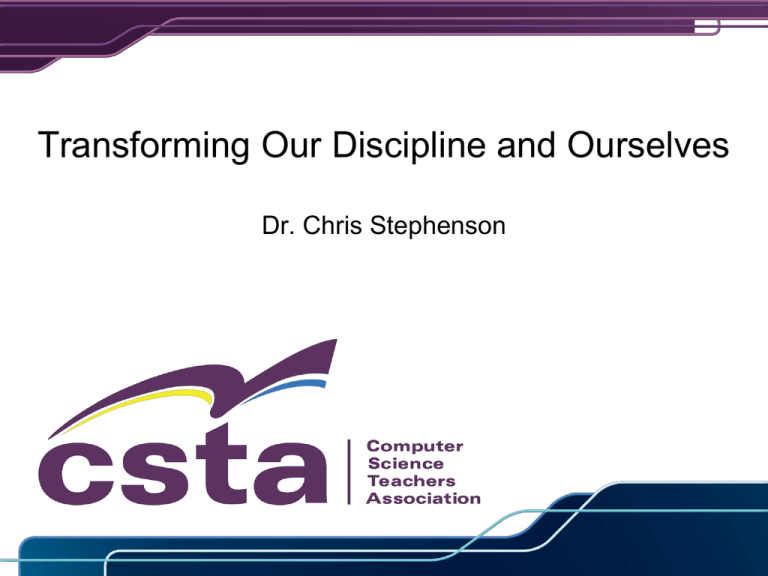
Transforming Our Discipline and Ourselves Dr. Chris Stephenson Agenda • CSTA • Computer science is crucial • Current challenges • Transformative Projects • Transformative Advocacy ©iStockphoto.com/bubaone The Computer Science Teachers Association CSTA Today CSTA is an international membership organization of 10,000 members • • • • • CSTA is a learning community CSTA is an advocacy organization CSTA is a provider of professional development for teachers CSTA is a research body CSTA is a provider of resources CSTA’s Mission • The Computer Science Teachers Association is a membership organization that supports and promotes the teaching of computer science and other computing disciplines. CSTA provides opportunities for K-12 teachers and students to better understand the computing disciplines and to more successfully prepare themselves to teach and learn. CSTA’s Goals and Objectives Creating a community of individuals and organizations working together to address critical issues in K-12 computer science education. Promote a Better Understanding of Computer Science: Provide visibility, influence policy, and generate resources that illuminate computer science as an essential academic discipline. Develop Research and Resources: Conduct original research and serve as a direct-to-practitioner channel for the dissemination of research and resources that address current knowledge gaps. Support National Standards: Facilitate the implementation of national curriculum and teacher certification standards to support consistent excellence in learning and teaching. Support Teacher Excellence: Provide multiple levels of professional development to improve teachers’ technical knowledge and pedagogical skills. Opportunities: Promote computer science as a field of study and as a career destination that provides a wealth of opportunities to students regardless of their gender, race, or socio -economic status. CSTA Resources • • Policy and Information Documents: The New Educational Imperative (International Ed.), Ensuring Exemplary Teaching in an Essential Discipline, Running on Empty CSTA posters • CSTA videos and podcasts • CSTA Voice bi-monthly publication • Source web repository with more than 200 unique resources: lesson plans, modules, presentations Every resource is reviewed by a committee of experts to ensure that it is complete, relevant, appropriate, and pedagogically sound o ©iStockphoto.com/Petrovich9 Computer Science as an Academic Discipline in K-12 Knowledge for Today and Beyond We consider it critical that students be able to read and write and understand the fundamentals of math, biology, chemistry and physics. To be a well-educated citizen in today’s computing-intensive world, students must have a deeper understanding of the fundamentals of computing as well. Defining Computer Science “Computer science is the study of computers and algorithmic processes, including their principles, their hardware and software designs, their applications, and their impact on society.” — The ACM Model Curriculum for K-12 Computer Science” http://csta.acm.org/Publications/sub/Documents.html Computer Science is Distinct from Literacy • Computer science is the study of computers and algorithmic processes, including their principles, their hardware and software designs, their applications, and their impact on society. (ACM Model Curriculum) • Computer Literacy: The ability to use various software applications (often called “point and click education”) • Educational Computing/Educational Technology: The use of computers to support learning across the curriculum Transferable Skills in an Interdisciplinary World Students who study computer science learn a number of vital skills that can be transferred to any subject area and contribute significantly to their performance as professionals: • Problem solving skills Problem definition, solution design, implementation, testing, revision Creativity, perseverance, teamwork • Design skills Designing and working to specifications • Logic and reasoning The ability to analyze a problem and break it down into a logical sequence of steps • Computational thinking Drawing on fundamental concepts in computer science to analyze and solve problems. Thinking at multiple levels of abstraction Current Challenges Very Scary Numbers Schools Offering Introductory Computer Science 2005 2007 2009 78% 73% 65% Schools Offering Advanced Placement Computer Science 2005 2007 2009 40% 32% 27% Systemic Challenges • • “elective” means no one is going to take your course • “access” is limited to high end schools with low minority populations “technology credit” means parents and competitive post-secondary CS programs don’t trust it • The myth of outsourcing trumps the reality of jobs, jobs, jobs • Nerds have bad hair CS Teacher Certification is a Total Mess • Many states have no requirements at all so anyone can teach computer science • Most people (teachers and administrators) don’t know what the requirements are in their own states • Some states have requirements that have absolutely no connection to computer science content or teaching • Some states have requirements that are impossible to meet (requiring teachers to have taught courses that do not exist) • Teacher preparation programs are not preparing computer science teachers because they are designed to prepare teachers for professional certification Transformative Projects A More Engaging AP CS Course • We are failing to engage young women and minority students. This isn’t just an equity issue, it is a survival issue. • Kids believe that taking the CS AP course will drag their GPA’s down • Our hopes for the new course: – A point of national leverage to raise the profile of K-12 CS education – An open door for all students – A sense of the beauty and creativity of CS, as well as its scientific relevance – A language-independent course that allows teachers to pick the best tools Curriculum Standards: Why We Need Them • • • • • • Broadly endorsed content Progression of courses that is pedagogically sound Clear definitions Framework for planning Benchmark for course development and selection Common benchmark for universities so they can evaluate incoming students The ACM/CSTA Model Curriculum • Published in: – 2003 – 2006: revised forward • More than 40,000 copies distributed • Used as the basis for curriculum development at the state and national level Standards are Organized into Levels Learning Outcomes Organized by Strands Timelines • • • • • • • • April 1: Draft completed April 15: Community review and feedback process begins June 5: Revision process begins August 1: Second draft completed August 15: Community endorsement process begins September 16: Final draft to layout November 18: Final version to printer December 16: Publication Draft Document The entire draft document is available at: http://csta.acm.org/includes/Other/CS_Standards.html Transformative Teaching Working With Students • Ask your students how to make your courses better (these are your consumers... learn how to sell to them) • Actively recruit (letters inviting students to take your classes, open house for students and parents) • Encourage students to explore a variety of course options • Use a project-based learning approach and encourage students to design projects that interest them • Use goal-oriented teaching strategies • Take kids on cool field trips and use the teachable moment (laser tag, simulators, local manufacturing industries that use robotics) • Bring back former students to talk about their experience at university or in the work world (near-peer mentors) • Bring in industry speakers Working With Other Teachers • Team teaching • Grade teams to focus on grade-specific learning strategies • Break down departmental fiefdoms and promote working together • Visit lower grades in other subject areas (math, science, tech) and talk to students about your program • Educate math and science teachers about your program and ask them to identify students who would benefit and then follow-up personally with those students • Get involved in a professional organization that is advocating for your discipline Working With Administrators • • • • • • • • Show how your courses align with national standards Send them copies of recent reports Send them briefings on your recent conferences or meetings Create an opportunity map that links your courses to postsecondary and workplace opportunities Develop a list of postsecondary programs that require computing skills Invite administrators to come and see your class in action If you have a parent in the industry, set up a meeting with you, the parent, and your administrator Lobby your administrator to make sure that your departments are organized in such a way that computing is perceived as an academic subject and that course codes are appropriate Working With Guidance Counselors • Do an annual presentation highlighting fun student projects • Provide a list of requisite skills for each of your courses • Create an opportunity map that links your courses to postsecondary and workplace opportunities • Develop a list of postsecondary programs that require computing skills • Give them copies of your textbooks • Invite them to come and see your class in action • Ask their advice Working With Colleges and Universities • Develop a relationship with local faculty to learn more about their requirements • Take your students on field trips • Invite faculty to come and speak to your class • Create an opportunity map that links your courses to postsecondary and workplace opportunities • Arrange to take your students to local career days • Invite your principal to meet your local faculty contacts • Lobby local universities and colleges to either require a high school computing course for entry into their program or to give special consideration to students who have taken them • Ask for their help • Ask them to support a local CSTA chapter Getting Funded • Demonstrate the need for up-to-date equipment • Discuss needs during staff evaluation • Learn about grant sources and get yourself a good book on grant writing • Offer to partner with local colleges and universities on NSF grants (iTEST, BPC, DRK-12) • Approach corporations about scholarships or support • Ask, ask, ask • Beg, beg, beg THANK YOU! Chris Stephenson Executive Director, CSTA Phone/Fax: 1-541-687-1840 cstephenson@csta.acm.org CSTA website: csta.acm.org
